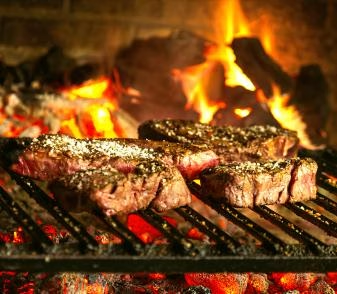Is the red juice that oozes from undercooked steak not what we think of as “blood”? These blood-like red juices are actually not blood, but rather the color caused by the protein “myoglobin” and water in the beef muscle.
The red juices that ooze from steak are primarily myoglobin, not blood.
Meat color is primarily influenced by two factors: the color of pigments in the blood and the pigments in the muscle. The red juices that appear in undercooked meat are not actually the color of blood, but rather the color of myoglobin and water in the muscle.
Because the hemoglobin in the blood vessels of animals is lost during the bleeding process after slaughter, the primary pigment that influences the color of meat is the myoglobin pigment in the muscle.
According to the U.S. Meat Export Federation, in well-bleeded muscle tissue, myoglobin outweighs hemoglobin, accounting for approximately 80-90% of the total pigment in muscle.
Thus, the color of raw meat at this stage is primarily due to myoglobin.
Myoglobin in muscle affects meat color and juiciness.
Myoglobin in muscle is a protein, also known as myoglobin. It is the source of pigment in muscle and also contains iron, which helps transport oxygen to the muscle. In the raw state of slaughtered meat, myoglobin has a significant impact on meat color.
When cooking meat, the myoglobin in the meat changes color due to the heat-cooking process. When beef is heated, the protein denatures and the iron in the hemoglobin oxidizes, causing the meat’s color to turn gray-brown.
However, when the meat is still uncooked, the myoglobin in the muscle tissue retains a darker red color, creating a juicy appearance when mixed with surrounding water and meat juices. This can lead people to mistakenly believe that the oozing of uncooked meat is “bloody,” but it is actually the fusion of myoglobin and water, resulting in a reddish color.
Does myoglobin content also influence the classification of red and white meat?
How else does myoglobin affect meat? According to the U.S. Meat Export Federation, the color of meat is influenced by the content and chemical state of the myoglobin pigment. Myoglobin levels vary depending on the animal species, age, activity level, and muscle location, affecting the color of the meat. Muscles with high myoglobin levels have a reddish color, while those with low myoglobin levels have a whiter color.
Meats like beef, lamb, and pork, which are high in myoglobin, are classified as red meat, while meats like chicken and fish, which are low in myoglobin, are classified as white meat. This is also the reason why the juices from beef and other meats appear reddish when seared, while those from chicken and other meats are more transparent.


Leave a Reply